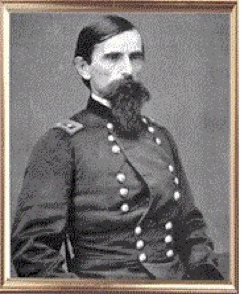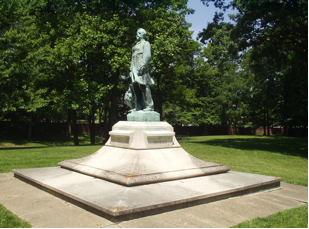
After the Civil War this Union General wrote America’s first historical novel entitled “Ben-Hur”, but very few persons today can give you his name. Hardly anyone knows of his life and of his great battlefield accomplishments. However, everyone will tell you that Charlton Heston played Ben Hur in the movie adaptation of the book.
“He comes from good stock,” they said when Lewis Wallace was born in Brookville, Indiana in 1827. His father was a West Point graduate, a local attorney, and later became the 6th Governor of the State of Indiana. At the age of nine, Lewis was sent to Wabash College, a small, private, liberal arts college for men located in Crawfordsville, Indiana. After his schooling, he joined his father in Indianapolis to study law. At the age of 19, Lew (as he prefered to be called) joined the 1st Indiana Infantry regiment and rose to the rank of first lieutenant during the American-Mexican War. When the war ended Lew went back to studying law and was admitted to the bar in 1849. In 1851 he was elected prosecuting attorney of Indiana’s First Congressional District and one year later married 22 year-old Susan Arnold Elston of Crawfordsville.
At the time of their engagement, Lew was a struggling attorney, and Susan's father, a Crawfordsville banker, was not particularly certain that he would ever be successful. Susan was then a talented musician and writer and during her life time had her stories published in over thirty magazines, newspapers, journals, and books of poetry. However, Susan preferred to remain largely in the shadows as her husband's companion. Lew frequently acknowledged that Susan was his editor, reader, and critic. He attributed his success to her criticism of his writings. The book Ben-Hur was dedicated to “THE WIFE OF MY YOUTH WHO STILL ABIDES WITH ME.”
At the outbreak of the Civil War, Lew Wallace was an Indiana State Senator, having been elected in 1856 as a member of the Democratic Party. He immediately offered his services to the Union Army and was commissioned a colonel in the 11th Indiana Regiment. His first engagement was at Romney, Virginia where his company overran a superior force and captured 2 cannons and a large quantity of Confederate supplies..
He was soon promoted to general and in 1862 fought at Fort Donelson and at the battle of Shiloh with Grant and Sherman. He was also in charge of the defense of Cincinnati, Ohio, being credited with saving the city from falling into Confederate hands. In 1864 he commanded a Union force of 5,800 at the Battle of Monocacy that held off an army of 28,000 Confederates marching toward Washington, D.C. After the war, Wallace was a member of the court-martial which tried the conspirators in the Lincoln assassination and he was president of the commission that tried and convicted Henry Wirz, commander of Andersonville Prison, Georgia.
Wallace defends Cincinnati
In 1862 the City of Cincinnati, Ohio, was about to be attack by a large military force of Confederate soldiers advancing northward from Lexington, Kentucky. Ohio State Governor David Tod quickly sent for Union General Lew Wallace to stop the southern army from crossing the Ohio River and invading Ohio. Wallace’s staff reminded him that there was nothing with which to defend the City of Cincinnati and that he was not bound to accept the command. The staff officers insisted that since the city had no army, artillery, nor fort, defense would be futile. Nevertheless, Wallace determined to try and turned briskly to a plan of his own. He announced that the 170,000 residents of the city would have to provide their own defense. Over Cincinnati and the opposite Kentucky towns of Covington and Newport, he proclaimed martial law, to be enforced by the police until they could be relieved by the military. At 9 a.m. on September 2, 1862, all businesses were to close down, and within an hour all citizens were to report for work details: ‘citizens for the labor, soldiers for the battle.’
Wallace’s decisiveness snapped the citizens out of their anxiety, and after the initial complaints that even marriages and milk delivery must be postponed, the residents turned up with revived morale. The Cincinnati Gazette announced, ‘To arms! The time for playing war has passed. The enemy is now approaching our doors!’ Wallace gave local surveyors and civil engineers a quick course in defensive fortifications and sent 15,000 citizens across the Ohio River with ‘ploughs, picks, shovels, and scrapers obtained from the hardware-stores to dig breastworks and rifle pits on the Kentucky shore. There was neither looting nor picnicking; all activity was strictly supervised. Wallace and his subordinates did an amazing job of organizing and directing all these forces, and supplying them with food and lodging. He posted 55,000 armed men behind breastworks stretching along the bend of the Ohio River at Cincinnati. Another 15,000 were stationed at possible fords, while sixteen steamboats armed with 6-pounder cannons patrolled the river.
When Confederate Brigadier General Henry Heth’s main column of soldiers appeared at Covington, he was stopped by Wallace’s defenses. For six days, the Confederate army probed for the weakest point, but Heth found the defenses too strong and withdrew during the night of September 11. The next morning found Cincinnati unthreatened and the Lexington pike once more open. Back in the city, there was ‘a splendid triumphal march, with music and banners’ through a cheering crowd. Wallace recalled it as ‘one of the gladdest days’ of his life.
Wallace’s Later Years
On November 30, 1865, Lew Wallace resigned from the U.S. military and held a number of important political posts during the 1870s. He was appointed the Governor of the New Mexico Territory from 1878 to 1881 by President Rutherford B. Hayes. Then President Garfield, a great admirer of Wallace, appointed him the U.S. Minister to the Ottoman Empire in Turkey. It was where that Wallace lived from 1881 to 1885.
Always a prolific writer, Wallace wrote The Fair God in 1873. It is a story about Montezuma's failed attempts to stop Cortez from invading the Aztec empire. It was while governor of New Mexico that Wallace wrote Ben-Hur – A Tale of the Christ, one of the best-selling books of the 19th century, which has been filmed three times, most famously the 1959 version with Charlton Heston in the title role. Not surprisingly, this book has never been out of print
Wallace’s Writings
The following is a list of Lew Wallace’s principal works and their dates:
Novels
The Fair God: A story of the Conquest of Mexico – 1873
Ben-Hur: A Tale of the Christ – 1880
The Prince of India: or Why Constantinople Fell – 1893
(This book contains 300,000 words and took 12 years to write.)
Stories………….The Boyhood of Christ – 1888
Poems………….The Wooing of Malkatoon – 1898
Plays……………Commodus – 1877
Miscellaneous…..The Life of Benjamin Harrison – 1888
The Story of American Heroism – 1896
An Autobiography – completed in 1906
by his wife and a year after his death.
General Lew Wallace Study & Museum
Today, Wallace’s Study is a separate standing brick building constructed by the General fifty yards north of his residence in Crawfordsville. It has been converted by the State of Indiana into a museum. It sits on a 3.5 acre parcel of land totally surrounded by a brick wall and it is beautifully landscaped with limited parking for visitors. I visited the museum in 2006 and found it to contain hundreds of artifacts that chronicle every aspect of his varied life. On one wall is a large oil painting done by the General while he was living in Turkey. It seems that Lew was not only a great story writer but also an accomplished artist. In the winter the General would retreat to his study to write his memoirs but is the summer he would sit under a giant beech tree next to study.
The beech tree has since died and has been replaced by a granite monument honoring his life as an author, soldier, statesman, and artist. Wallace once wrote, “I want a study, a pleasure-house for my soul, where no one could hear me make speeches to myself, and play the violin at midnight if I chose; a detached room away from the world and its worries. A place for my old age to rest in and grow reminiscent, fighting the battles of youth over again."

Monument at the Wallace Museum
Other Monuments
Wallace died in 1905, likely from cancer, in Crawfordsville, Indiana, at the age of 77. He is buried there in the Oak Hill Cemetery along with his wife, Susan, who died in 1907, also at the age of 77. The Wallaces’ grave site is marked with a tall granite obelisk.
In 1910, the State of Indiana placed a life-sized marble statue of General Wallace in the National Statuary Hall located in the U.S. Capitol Building in Washington D.C. (The National Statuary Hall Collection consists of 100 statues with each state having contributed two statues.) The statue is a duplicate of the one located at the Wallace Museum in Crawfordsville and shown above.
